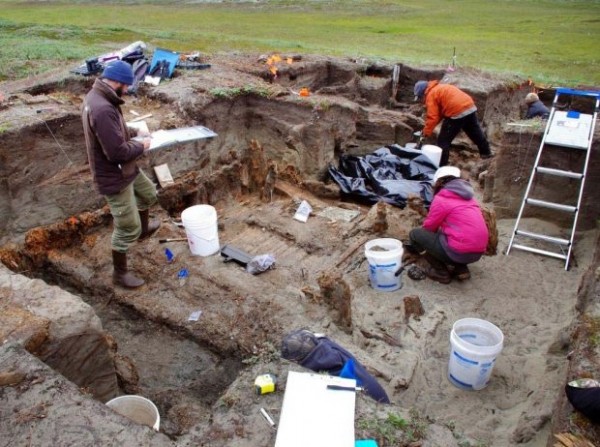Prehistoric Artifacts Shows Asian Trade in Alaska
| Marco Foronda | | Apr 22, 2015 11:45 AM EDT |
(Photo : University of Colorado) Researchers excavate an Inupiat Eskimo home at Cape Espenberg in 2011.
Bering Land Ridge National Preserve researchers have confirmed that bronze artifacts in an old house in Alaska dating back to 1,000 years was a trading place between East Asia and New World centuries before the voyage of Columbus.
Archaeologists found the artifacts at the "Rising Whale" site at Cape Espenberg.
Like Us on Facebook
"When you're looking at the site from a little ways away, it looks like a bowhead coming to the surface. We're seeing the interactions, indirect as they are, with these so-called 'high civilizations' of China, Korea or Yakutia, a region in Russia," said Owen Mason, a research associate at University of Colorado and part of the excavation.
Since bronze-working wasn't fully developed in Alaska, archaeologists believe the artifacts were manufactured in East Asia and made its way to Alaska through trading routes.
Along with the bronze items were remains of obsidian artifacts. The obsidian items' chemical signatures shows signs it came from Russia, or from the Anadyr River valley to be exact.
Most researchers noted the similarities of the design of the plate armor worn by people in Alaska and that are worn mostly in China, Korea, Japan and eastern Mongolia.
Genetic research also showed there were indeed interactions between peoples from East Asia and the New World.
A lot of different hypotheses suggest people may have reached the New World before Columbus. There is one idea that keeps getting the attention of media: Chinese mariners sailed directly to the New World. This idea, however, lacks scholarly support.
Mason and his team will discuss their research about the Rising Whale site in St. John's Newfoundland, Canada as part of the Canadian Archaeological Association annual meeting on April 28 and May 2.
TagsPrehistoric Artifact Shows Asian Trade in Alaska, Rising Whale, Bronze, Alaska, Trade, market trade, Russia, artifacts, Columbus, ancient trade
©2015 Chinatopix All rights reserved. Do not reproduce without permission
EDITOR'S PICKS
-

Did the Trump administration just announce plans for a trade war with ‘hostile’ China and Russia?
-

US Senate passes Taiwan travel bill slammed by China
-

As Yan Sihong’s family grieves, here are other Chinese students who went missing abroad. Some have never been found
-

Beijing blasts Western critics who ‘smear China’ with the term sharp power
-

China Envoy Seeks to Defuse Tensions With U.S. as a Trade War Brews
-

Singapore's Deputy PM Provides Bitcoin Vote of Confidence Amid China's Blanket Bans
-

China warns investors over risks in overseas virtual currency trading
-

Chinese government most trustworthy: survey
-

Kashima Antlers On Course For Back-To-Back Titles
MOST POPULAR
LATEST NEWS
Zhou Yongkang: China's Former Security Chief Sentenced to Life in Prison

China's former Chief of the Ministry of Public Security, Zhou Yongkang, has been given a life sentence after he was found guilty of abusing his office, bribery and deliberately ... Full Article
TRENDING STORY

China Pork Prices Expected to Stabilize As The Supplies Recover

Elephone P9000 Smartphone is now on Sale on Amazon India

There's a Big Chance Cliffhangers Won't Still Be Resolved When Grey's Anatomy Season 13 Returns

Supreme Court Ruled on Samsung vs Apple Dispute for Patent Infringement

Microsoft Surface Pro 5 Rumors and Release Date: What is the Latest?










